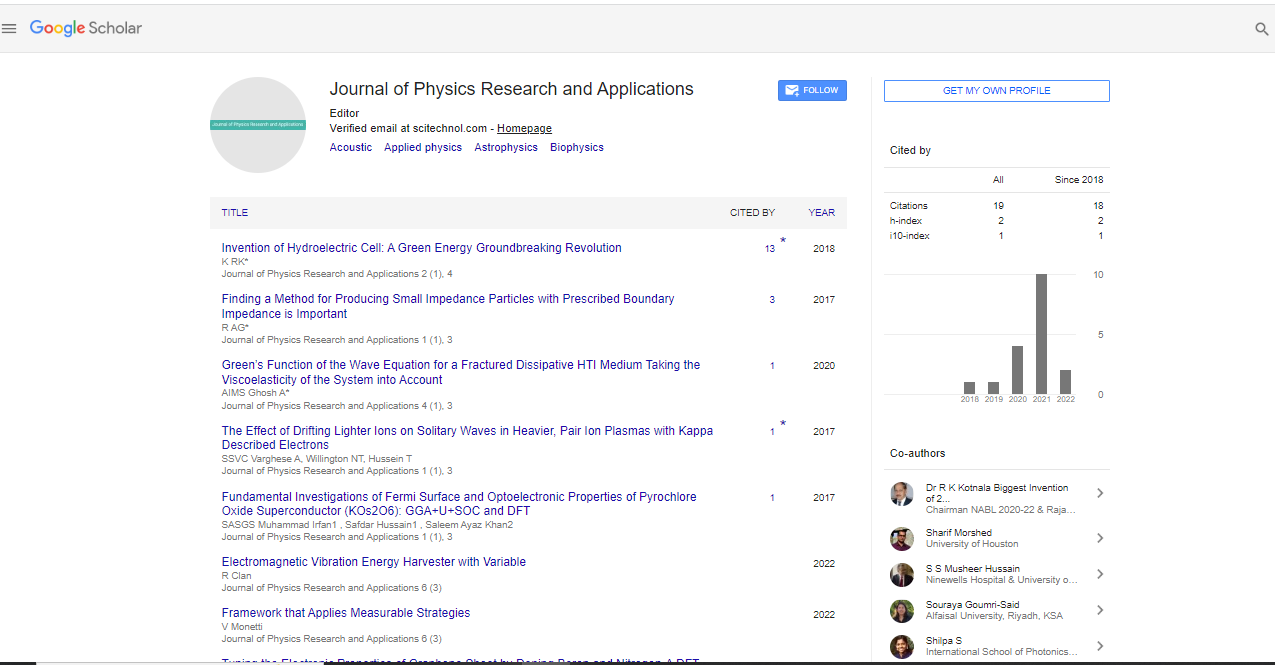Short Communication, J Phys Res Appl Vol: 8 Issue: 4
Seismic Waves and their Role in Mapping Earth’s Interior
Lisa George*
1Department of Physics, University of Texas, Texas, USA
*Corresponding Author: Lisa George,
Department of physics, University of Ohio,
Ohio, USA
E-mail: lisa@grg.edu
Received: 19 November, 2024, Manuscript No. JPRA-24-156505;
Editor assigned: 21 November, 2024, PreQC No. JPRA-24-156505 (PQ);
Reviewed: 06 December, 2024, QC No. JPRA-24-156505;
Revised: 13 December, 2024, Manuscript No. JPRA-24-156505 (R);
Published: 20 December, 2024, DOI: 10.4172/JPRA.1000128.
Citation: George L (2024) Seismic Waves and their Role in Mapping Earth’s Interior. J Phys Res Appl 8:4.
Description
Seismic waves are essential tools in geophysics, used to investigate the Earth's interior. By analyzing how seismic waves travel through different layers of the Earth, scientists can gain valuable insights into its composition, structure and physical properties. These waves, generated by natural events such as earthquakes or artificial sources like explosions, provide important information about the hidden layers beneath Earth's surface. Seismic waves are disturbances that propagate through the Earth's materials, carrying energy from the source of an earthquake or other seismic event. There are two main types of seismic waves: Body waves and surface waves [1,2].
Body waves travel through the interior of the Earth and are divided into two subtypes: P-waves (Primary or pressure waves) and S-waves (Secondary or shear waves). P-waves are longitudinal waves, meaning that the particles of the material move in the same direction as the wave itself. They are the fastest seismic waves and can travel through both solid and liquid materials. Because of their ability to travel through all layers of the Earth, they are the first to be detected by seismographs after an earthquake. S-waves are transverse waves, meaning that the particles move perpendicular to the direction of the wave. Unlike P-waves, S-waves can only travel through solid materials and are slower than P-waves. Their inability to travel through the Earth's liquid outer core has provided scientists with essential clues about the Earth’s structure [3,4].
Surface waves travel along the Earth's surface and are slower than both P-waves and S-waves. Although they are less useful for studying the interior, surface waves cause much of the damage during an earthquake due to their larger amplitude. Surface waves are classified into Love waves and Rayleigh waves, which cause horizontal and vertical ground movements, respectively. Seismic waves play an essential role in studying the Earth’s internal structure. By analyzing the speed, direction and path of seismic waves as they travel through the Earth, scientists can infer the composition and physical state of different layers. These layers include the Earth's crust, mantle, outer core and inner core [5,6].
Seismic waves travel at different speeds depending on the material they move through. When seismic waves encounter a boundary between different materials, such as the crust and the mantle, they change speed and direction. This phenomenon is known as a seismic discontinuity. P-waves travel through the mantle, but S-waves stop at a depth of around 1,800 kilometers, indicating that the mantle behaves differently at various depths . The difference in seismic wave behavior at different depths suggests that the mantle is not uniform but may have variations in temperature, composition and state [7,8].
The outer core, which is liquid, is the key to understanding the Earth’s magnetic field. Seismic waves provide evidence of the outer core's liquid state because S-waves cannot travel through liquids. When seismic waves travel from the mantle into the outer core, Swaves are absorbed, while P-waves continue to travel through. The refraction of P-waves and the complete absence of S-waves in the outer core have allowed geophysicists to confirm the liquid nature of this layer. Below the outer core lies the inner core, which is solid despite the high temperatures. P-waves continue to travel through the inner core, but they slow down, suggesting that the inner core is denser than the outer core. The speed of P-waves increases once they pass through the inner core, indicating a solid structure. The study of seismic wave propagation through these layers has been instrumental in forming our current understanding of the Earth's core [9,10]
References
- Tromp J (2020) Seismic wavefield imaging of Earth’s interior across scales. Nat Rev Earth Environ 1:40-53.
- Curtis A, Snieder R (2002) Probing the Earth's interior with seismic tomography. Int Geophys Ser 81:861.
- Krasnoshchekov DN, Kaazik PB, Ovtchinnikov VM (2005) Seismological evidence for mosaic structure of the surface of the Earth's inner core. Nature. 435:483-437.
- Ritsema J, Lekic V(2020) Heterogeneity of seismic wave velocity in earth's mantle. Annu Rev Earth Planet Sci 48:377-401.
- Rawlinson N, Pozgay S, Fishwick S (2010) Seismic tomography: A window into deep Earth. Phys Earth Planet Inter 178:101-135.
- Honda H (1962) Earthquake mechanism and seismic waves. Elsevier 10:1-97. [Google Scholar] [Crossref]
- Li B, Liebermann RC (2007) Indoor seismology by probing the earth's interior by using sound velocity measurements at high pressures and temperatures. Proc Natl Acad Sci 104:9145-9150.
- Woodhouse JH, Dziewonski AM (1989) Seismic modelling of the earth’s large-scale three-dimensional structure. Math Phys Sci 328:291-308.
- Webb SC (2008) The earth's hum: The excitation of earth normal modes by ocean waves. Geophys J Int 174(2):542-566.
- Anderson DL, Dziewonski AM (1984) Seismic tomography. Sci Am 251(4):60-71.
 Spanish
Spanish  Chinese
Chinese  Russian
Russian  German
German  French
French  Japanese
Japanese  Portuguese
Portuguese  Hindi
Hindi 
